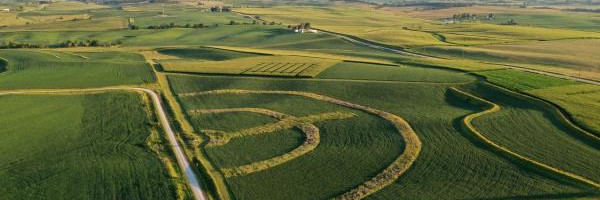Wireless Living Lab for Smart Agriculture and Rural Communities
| Wireless Living Lab for Smart Agriculture and Rural Communities | |
|---|---|

| |
 Smart Agriculture and Rural Communities | |
| Team Organizations | Iowa State University Plant Science Institute Research Farms |
| Team Leaders | Hongwei Zhang |
| Participating Municipalities | Iowa State |
| Status | Launched |
| Document | None |
Description
- Establish a wireless living lab at an Iowa State University research farm for cross-domain, cross-discipline research, education, and pilot of smart ag and rural connectivity solutions
- Work with wireless and agriculture research and education communities as well as potential rural communities in scaling the living lab software and hardware systems as well as services
Challenges
Rural prosperity is essential to US well-being. As a foundation for rural economy and quality of life, wireless connectivity is a key driver. However, 39% of the rural US lacks broadband access, and most ag farms are not connected at all. In addition, there are no at-scale, real-world experimental platforms for developing advanced wireless solutions for the rural US.
Solutions
{{{solutions}}}
Major Requirements
To enable smart agriculture research and education and rural connectivity, we will establish a wireless living lab CyNet at Iowa State University. CyNet features advanced, field-deployed wireless networks with open-source hardware and software platforms, 10Gbps software-defined optical networks, and high-performance cloud computing infrastructures, and it will be connected to national infrastructures such as GENI and NSFCloud. To transform the CyNet hardware platforms into a software-defined, shared-use infrastructure for different communities, we will develop the CyNet software system to infrastructure virtualization and co-creation within CyNet user communities.
Performance Targets
| Key Performance Indicators (KPIs) | Measurement Methods |
|---|---|
|
Through the project, we will develop and deploy the following software systems in the CyNet infrastructure: 1) Predictable, Reliable, Real-time, and high-Throughput (PRRT) wireless networking solutions from Hongwei Zhang's research group; 2) Infrastructure virtualization system that partitions CyNet into programmable, isolated slices; and 3) Infrastructure management system that performs admission and access control and that decides specific resource allocation policies so that CyNet users can securely access the CyNet infrastructure accordingly. |
We will measure the wireless networking performance (e.g., throughput, reliability, and timeliness) of CyNet in real-world agriculture research and education uses. |
Standards, Replicability, Scalability, and Sustainability
- CyNet will be developed and deployed using open-source hardware and software platforms (e.g., USRP SDRs and OpenAirInterface), thus facilitating replicating the system into other universities and communities.
- CyNet can be scaled to large producer farms and communities by using wireless backhaul solutions and by deploying more wireless base stations.
- As an essential infrastructure for research, education, and pilot demonstration/deployment of smart agriculture and rural connectivity solutions, CyNet will engage diverse, broad user communities, which will help sustain the infrastructure itself.
Cybersecurity and Privacy
Security and privacy-protection mechanisms such as virtualization, authentication, and least-privilege access control will be adopted.
Impacts
CyNet is expected to stimulate research and field deployment of PRRT wireless networks (e.g., those considered in 5G and beyond), to enable transformative plant science studies and farming practice, and to enable exciting interdisciplinary education activities in networking, computing, agriculture, and smart and connected rural communities, and it will help engage under-represented students in STEM education.
Demonstration/Deployment
This NSF project has just been launched. It will not be operational by early 2019, but we will be happy to present a poster about the project at the GCTC Expo’19. The CyNet infrastructure is expected to be operational around 2020/2021. We are also currently exploring approaches (e.g., potentially through the NSF PAWR program) to scaling up the CyNet infrastructure into rural communities and producer farms surrounding Iowa State University.